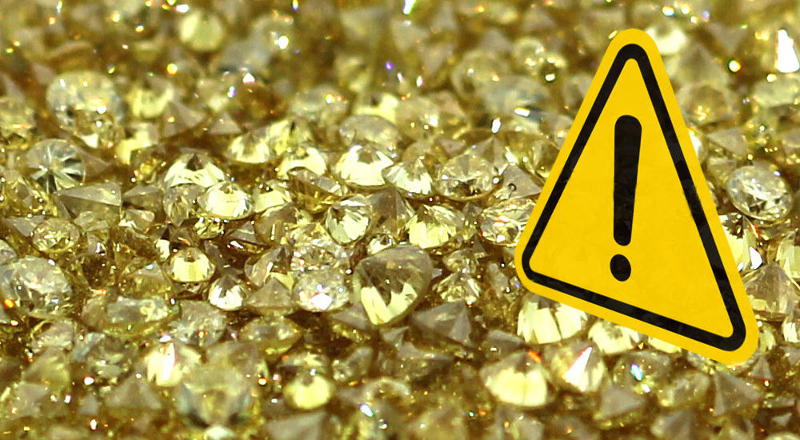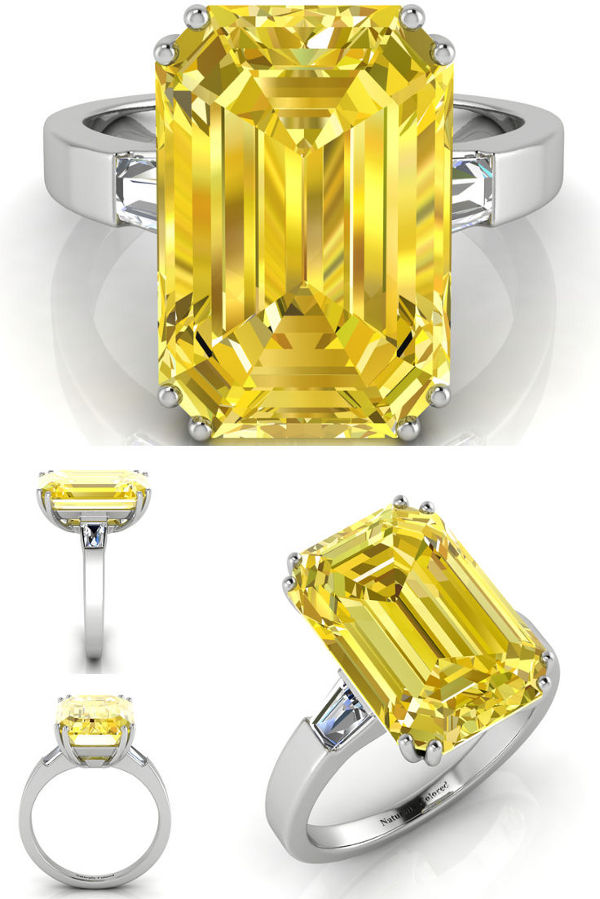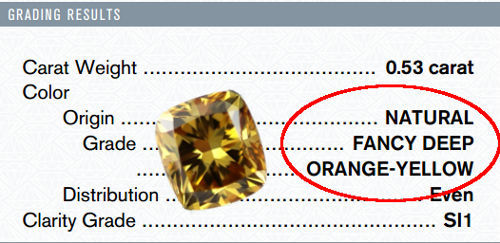What to Watch for When Buying Yellow Diamonds?
- Home /
- Diamond Buying Guides /
- What to Watch for When Buying Yellow Diamonds?

Yellow diamonds are the most commonly known form of colored diamonds and among the most sought after colors within the colored diamonds family.
The reasons are quite understanable but here the most obvious ones:
- While other colored diamonds may go unnoticed or is some cases simply mistaken for gems, the beautiful and strong color of yellow diamonds that is often accompanied by strong brilliance does not go unnoticed.
- Yellow diamonds are often seen worn by celebrities. Take for example Heidi Klum's engagement ring. Not long ago George Clooney proposed to Amal with a yellow diamond engagement ring and the list goes on and on, even beyond celebs to personas such as Hillary Clinton.
- Although Yellow diamonds are in fact extremely rare, their prices are very affordable (as far as diamonds can be considered affordable). When comparing prices of colored diamonds to colorless diamonds you'd note that yellow diamonds up to the intensity of the notable fancy are priced the same as white diamonds if not less.
But now that we've established that they are "that good", where is the catch?
DO NOT Buy Canary Diamonds!
 Clooney's canary engagement ring illustration
Clooney's canary engagement ring illustration
Sounds weird?
For those of you who don't know, canary diamonds is an synonym to yellow diamonds.
And if we wish to be more accurate, as the color of the canary bird, it refers to pure yellow diamonds (diamonds with no secondary tones), with strong intensity. If I need to choose one exact equivalent GIA definition for a canary diamond it would have need to be an Intense Yellow Diamond.
But where is the problem in that?
Being around for a while I've encountered on several occasions that people are presented with (or sold) "canary diamonds".
There is no such thing – it is an alias, just like one should not buy a certified cognac diamond.
It means that the diamond probably does not have a gemological certificate but rather in-house grading (and often even a luxury house).
Since you do intend to spend so much on a diamond, make sure to buy a graded one.
A Gemological Certificate is NOT enough with Yellow Diamonds!
There are many many gemological certificates. And I have the highest respect for three or even four of them – for colorless diamonds! When it comes to natural colored diamonds the ONLY authority on my book (as well as almost everyone else) is the GIA's.
But don't trust my word for it, there is an extremely easy way to check it. There are quite a few websites that deal in natural fancy colored diamonds, some more authoritive than others. Just find one that keeps GIA certified colored diamonds as well as other – usually the GIA. Once inside just compare the prices of a GIA colored diamond to an IGI colored diamond with the same grading… and voila… Surprise surprise – The GIA Pink Diamond costs twice as much than the IGI Pink Diamond… (if not more).
And if that is the case, why doesn’t the dealer get a GIA grading for the IGI diamond? Usually it's simply because that the GIA would give a different grading. For example – an IGI Intense Pink might be Fancy pink in the eyes of the GIA. And a fancy pink might be interpreted as a brownish pink or a light pink… These are small yet far from being negligible differences.
GIA certificate is Still NOT Enough!
To be honest, the title here is a bit of a teaser meant to catch your eye due to the previous title here above – but it doesn't mean that it is not true. A GIA certificate is a must – or in other words – a necessary condition but not a sufficient condition.
 GIA certificate of a Fancy Deep Orange Yellow Diamond
GIA certificate of a Fancy Deep Orange Yellow DiamondWhat the GIA certificate gives you is assurance (and in a way also insurance). Insurance that objective Gemologists graded the diamond and documented their findings. In some cases in colored diamonds, you would be able to find to diamonds with exact same certificate that look completely different. This is because there is a limit to the number of colors that the GIA fragments its findings which is obviously far less than the number of colors the eye can identify. However, this is less problematic when it comes to yellows and especially pure yellows.
Diamond Education
The problem is actually at your end… the buyer. Do you know how to read the findings? Do you know what they mean? How these finding impact on the value of a yellow diamond? Did you know for example that while in most colored diamonds fluorescence is not that important but fluorescence in yellow diamonds reduces the price dramatically?
For this I can only recommend doing research… Google around, read articles, participate in reputable forums such as Pricescope – and even approach & contact diamond dealers - I am certain many would be more than happy to share their knowledge with you. Thanks to the Internet it is not that hard to do – just takes a bit of time.
While this section mainly presented what not to do, there is also a lot you can do in order to harness the weirdness of the diamond industry in your behalf and even dramatically reduce prices.
If you are up to it, you are welcomed to browse our Yellow Diamonds Buying Guide…
